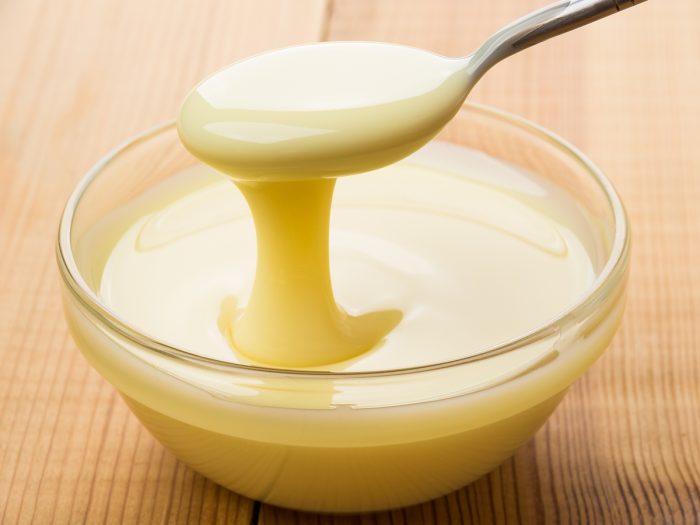The use of condensed milk is quite popular in many places around the world, thanks to its versatility, nutrient density, and reduced volume of regular milk.
What is Condensed Milk?
Condensed milk is a form of cow’s milk that has had the majority of water removed from it, leaving behind a thick, milk paste. You can add water to this concentrated paste to make regular milk, but it has a very long shelf life and can be easily transported in its dehydrated form. You will typically find this in the form of sweetened condensed milk, as sugar is usually added to it for flavor. This alternative to normal milk is very useful in culinary applications, particularly in rich desserts, thanks to its sweet taste. This form of milk should be consumed in limited quantities, due to the high caloric content. [1]

Condensed milk can take hours to make with endless stirring. Photo Credit: Shutterstock
Condensed Milk Nutrition
This type of dehydrated milk has a number of impressive nutrient components, including 2 grams of fat and roughly 60 calories per tablespoon. You will also get a solid dose of amino acids in condensed milk, along with notable levels of calcium, potassium, magnesium, and vitamin A. This type of milk is high in sugar but does provide about 1.5 grams of protein per tablespoon. Again, moderation is key when consuming this milk alternative, as excessive consumption can lead to obesity, issues with blood sugar and cardiovascular concerns. [2]
Serving Size : Nutrient Value Water [g] 27.16 Energy 321 Energy [kJ] 1342 Protein [g] 7.91 Total lipid (fat) [g] 8.7 Ash [g] 1.83 Carbohydrate, by difference [g] 54.4 Sugars, total including NLEA [g] 54.4 Calcium, Ca [mg] 284 Iron, Fe [mg] 0.19 Magnesium, Mg [mg] 26 Phosphorus, P [mg] 253 Potassium, K [mg] 371 Sodium, Na [mg] 127 Zinc, Zn [mg] 0.94 Copper, Cu [mg] 0.02 Manganese, Mn [mg] 0.01 Selenium, Se [µg] 14.8 Vitamin C, total ascorbic acid [mg] 2.6 Thiamin [mg] 0.09 Riboflavin [mg] 0.42 Niacin [mg] 0.21 Pantothenic acid [mg] 0.75 Vitamin B-6 [mg] 0.05 Folate, total [µg] 11 Folate, food [µg] 11 Folate, DFE [µg] 11 Choline, total [mg] 89.1 Vitamin B-12 [µg] 0.44 Vitamin A, RAE [µg] 74 Retinol [µg] 73 Carotene, beta [µg] 14 Vitamin A, IU [IU] 267 Vitamin E (alpha-tocopherol) [mg] 0.16 Vitamin D (D2 + D3), International Units [IU] 6 Vitamin D (D2 + D3) [µg] 0.2 Vitamin D3 (cholecalciferol) [µg] 0.2 Vitamin K (phylloquinone) [µg] 0.6 Fatty acids, total saturated [g] 5.49 4:0 [g] 0.28 6:0 [g] 0.17 8:0 [g] 0.1 10:0 [g] 0.07 12:0 [g] 0.18 14:0 [g] 0.78 16:0 [g] 2.4 18:0 [g] 1.21 Fatty acids, total monounsaturated [g] 2.43 16:1 [g] 0.14 18:1 [g] 2.19 Fatty acids, total polyunsaturated [g] 0.34 18:2 [g] 0.22 18:3 [g] 0.12 Cholesterol [mg] 34 Tryptophan [g] 0.11 Threonine [g] 0.36 Isoleucine [g] 0.48 Leucine [g] 0.78 Lysine [g] 0.63 Methionine [g] 0.2 Cystine [g] 0.07 Phenylalanine [g] 0.38 Tyrosine [g] 0.38 Valine [g] 0.53 Arginine [g] 0.29 Histidine [g] 0.21 Alanine [g] 0.27 Aspartic acid [g] 0.6 Glutamic acid [g] 1.66 Glycine [g] 0.17 Proline [g] 0.77 Serine [g] 0.43 Sources include : USDA [3]
Condensed Milk Uses
Due to the versatility and shelf life of condensed milk, it has become a favorite in many kitchens and recipes, as it is ideal for various desserts, iced coffee, and as a topping for fruits or savory dishes.
Desserts
Due to the concentrated sweetness and high sugar content of this milk variety, it is often included in the preparation of desserts, including cakes, cookies, and brownies. It provides a creamy and smooth texture to rich desserts, as well as a toasted undertone that is popular in holiday baking. [4]
Beverage Ingredient
If you want to add condensed milk to your iced tea or coffee, you can make a thicker and creamier beverage that has a sweeter-than-average aftertaste. It is also a great way to temper overly bitter brews of coffee or tea. [5]
Fruit Topping
Many people enjoy using condensed milk as a sweet topping for fruit salads since it can accentuate certain flavors. Furthermore, it is great for spreading over fruit before putting it in the oven, as the milk will speed the caramelization process, thanks to the high content of sugar. [6]
Savory Dishes
Although most recipes using condensed milk are sweet in nature, you can use this milk variety in savory dishes, such as in glazes or sauces for curries, protein dishes, kebabs or other cream-based preparations. Combining condensed milk with coconut results in a delectable sauce that can be added to many savory Asian meals. [7]
